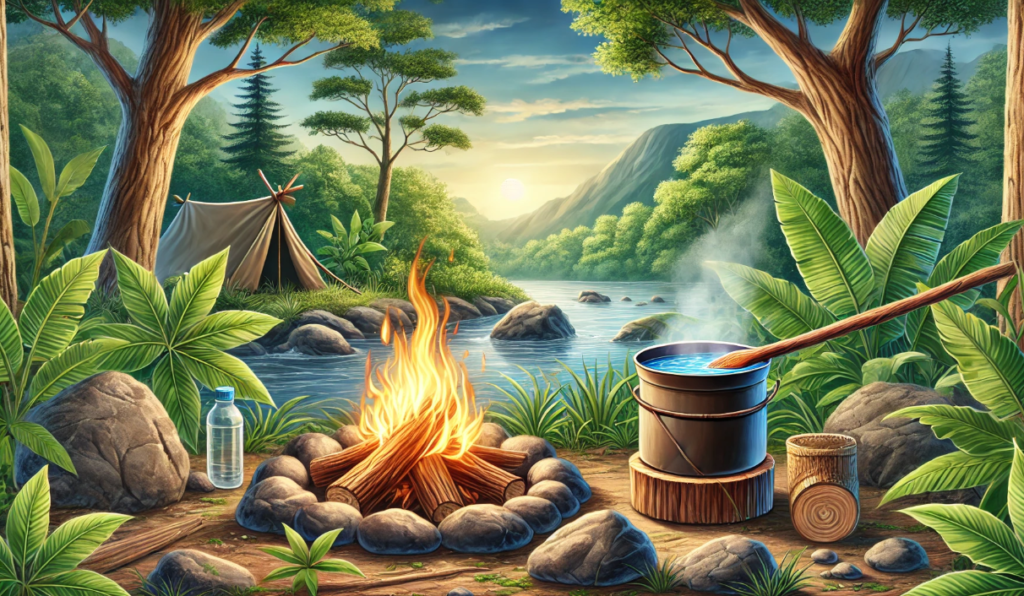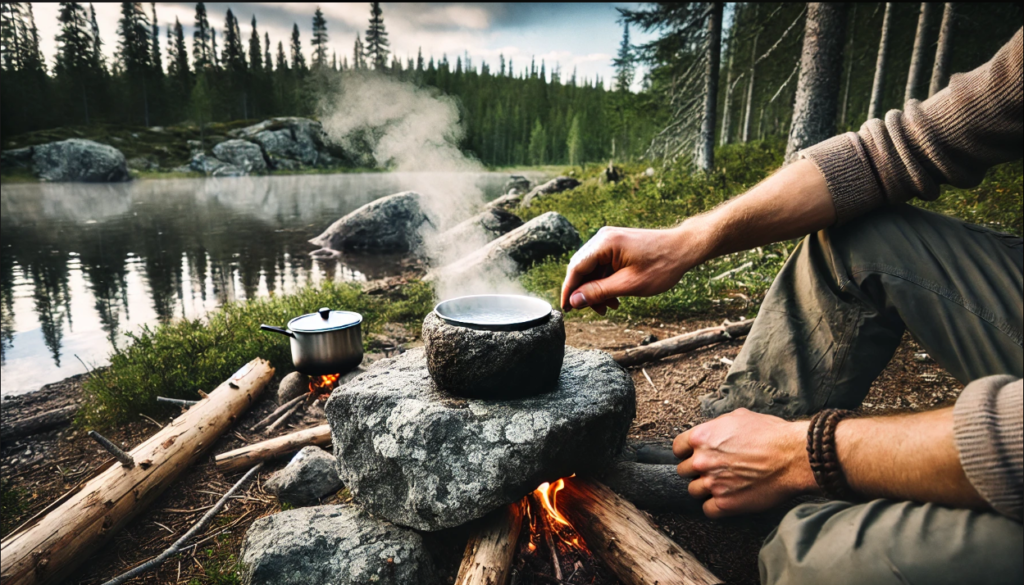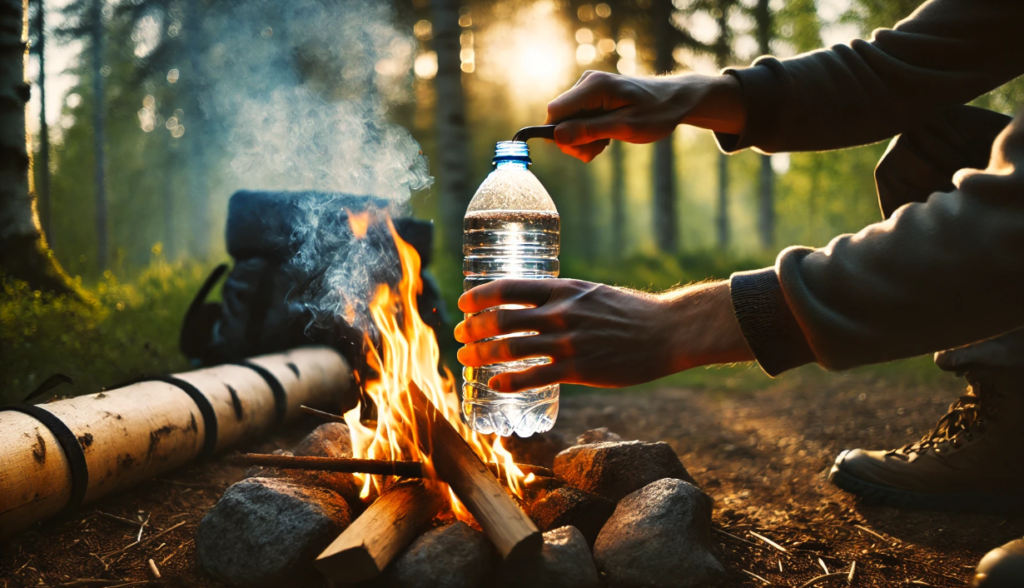Boiling water in the wild without a pot might sound impossible, but with a little creativity, it’s entirely doable. Whether you’re purifying water for drinking or cooking, these practical techniques will help you stay prepared and safe in any outdoor adventure.
Don’t panic! With a bit of creativity and some wilderness know-how, you can safely boil water and stay hydrated. Let me show you how to turn the resources around you into lifesaving tools.
Why Knowing How to Boil Water in the Wild Without a Pot Is Essential
We all know that drinking untreated water from natural sources can pose serious health risks. Rivers, lakes, and streams might seem like clean sources of hydration, but they’re often full of harmful bacteria, parasites, and other microorganisms. Boiling water kills most of these contaminants, making it safe to drink.
But here’s the catch: in a true survival situation, you might not have access to a pot or kettle. So, knowing how to boil water without one is not just a useful skill—it’s a life-saving one. Whether your gear got lost, damaged, or you’re simply trying to minimize weight on your backpacking trip, being able to boil water in alternative ways can provide you with safe drinking water when it matters most.

Basic Principles of Boiling Water Without a Pot
Before we jump into the specific methods, let’s cover a few basic principles about boiling water in the wild.
When you boil water, you’re applying enough heat to turn it into steam, which destroys harmful microorganisms. To do this without a pot, you need something to contain the water while applying heat, and it’s important that the material can withstand the heat without falling apart or contaminating the water.
The heat source is also crucial. A campfire is the most common option, but even using hot rocks or the sun’s rays can help you heat the water. You’ll also want to make sure you have safe, heat-resistant materials to hold the water.
Creative Techniques to Boil Water in the Wild Without a Pot

Now, let’s get into the fun (and practical) part—how to actually boil water without a pot.
Using Hot Rocks Method
This is one of the oldest and most effective methods for boiling water in the wild. You’ll need to heat some rocks in a fire until they’re extremely hot. The trick is to get the rocks hot enough to transfer heat into the water without breaking.
Here’s how it works:
- Start a fire and let it burn down until you have a good supply of hot coals.
- Find a few sturdy rocks (preferably river rocks, as these are less likely to crack).
- Place the rocks in the fire for 20-30 minutes.
- While the rocks are heating up, find a natural container to hold your water. You can use large, thick leaves, bark, or even a hollowed-out log.
- Once the rocks are hot, carefully remove them from the fire (use tongs or a stick to avoid burns), and place them directly into the water. The heat from the rocks will quickly raise the temperature of the water.
- Repeat if needed until the water starts to boil.
This method is perfect for boiling water when you’re in a pinch, especially if you don’t have any other containers.
Using a Plastic Bottle

You might think plastic would melt or catch fire too easily, but if you handle it carefully, a plastic bottle can serve as an excellent water-boiling tool. This works best when you have access to a small, controlled fire.
Here’s how you can do it:
- Fill a plastic bottle (preferably one made from thick, heat-resistant plastic) with water.
- Hold the bottle over the fire, keeping the heat low to avoid melting the plastic.
- Slowly heat the bottle. The water inside will eventually start to boil.
- Make sure the water isn’t in direct contact with the flames to prevent the bottle from catching fire or melting.
Be sure to monitor it closely and never leave it unattended.
Using a Bamboo Container
Bamboo is a fantastic material in the wild for survival. It’s strong, heat-resistant, and can easily be shaped into various tools. If you find a thick bamboo stalk, it can be used to hold water for boiling.
Here’s what you need to do:
- Cut a section of bamboo to use as a container.
- Split the bamboo open to remove the inner pulp, creating a hollow tube.
- Place the bamboo tube over a fire, ensuring that it’s not in direct contact with the flames. The heat will slowly raise the temperature of the water inside.
- Once the water starts boiling, carefully remove the bamboo from the fire.
Bamboo is a fantastic natural container, and it’s also eco-friendly!
Using Large Leaves or Bark
In the absence of a pot, large, durable leaves or tree bark can serve as a makeshift container. The trick here is to find leaves that are heat-resistant enough to withstand the heat from the fire.
Steps to follow:
- Find large, durable leaves (like those from a broadleaf tree) or flexible tree bark.
- Fold the leaves or bark to create a container.
- Fill it with water and carefully place it near or on the edge of the fire.
- Once the water starts to boil, remove the container and enjoy the results.
This method is especially useful if you’re in an area with an abundance of foliage.
Building an Earth Oven
An earth oven is a more complex but incredibly effective way to boil water without a pot. It involves digging a hole, lining it with stones, and using the earth to trap heat. The process may take a little longer but is highly efficient.
Steps:
Cover the pit with dirt and leave it for an hour or more. The heat will transfer to your container, boiling the water.
Dig a small pit in the ground.
Fill the pit with hot rocks (these should be heated in a separate fire).
Once the rocks are hot, place your container (whether it’s a bamboo tube, bark, or other material) in the pit.
Alternative Heat Sources for Boiling Water
You can get creative with your heat sources, too. While a campfire is the obvious go-to, you can use other heat sources depending on your environment.
Hot Sand: In desert environments, you can use the heat from the sand to heat containers of water by burying them just beneath the surface.
Solar Energy: If you’re in a sunny environment, a solar still can be a great alternative. While it won’t boil the water to a rolling boil, it can purify water over time.
Safety Tips for Boiling Water in the Wild
Handling hot rocks or containers of boiling water comes with risks, so here are a few safety tips:
Ensure that the water cools slightly before drinking to avoid burns.
Always use tongs, sticks, or gloves to handle hot materials.
Be cautious with plastic bottles—they’re easy to melt, so make sure they’re not too close to the flame.
Choose non-toxic materials for your containers to avoid contamination.
How to Practice and Prepare Before Your Next Adventure
The best way to prepare for boiling water in the wild without a pot is to practice. Next time you’re out camping or hiking, try out these methods in a safe, controlled environment. Learn how long each method takes, and what tools or materials work best for you.
Also, consider carrying a few survival essentials—like a metal container or a small fire starter kit—to make boiling water more straightforward when you’re out in the wild.The best way to prepare for boiling water in the wild without a pot is to practice. Next time you’re out camping or hiking, try out these methods in a safe, controlled environment. Learn how long each method takes, and what tools or materials work best for you.
Also, consider carrying a few survival essentials—like a metal container or a small fire starter kit—to make boiling water more straightforward when you’re out in the wild.
Final Words
Knowing how to boil water in the wild without a pot is an invaluable skill. Whether you’re looking to purify drinking water, cook food, or just improve your overall survival skills, mastering these creative methods can help you stay hydrated and healthy in the great outdoors.
Remember, it’s all about being resourceful and making the most of your environment. Practice these techniques, and you’ll be better prepared for your next adventure!